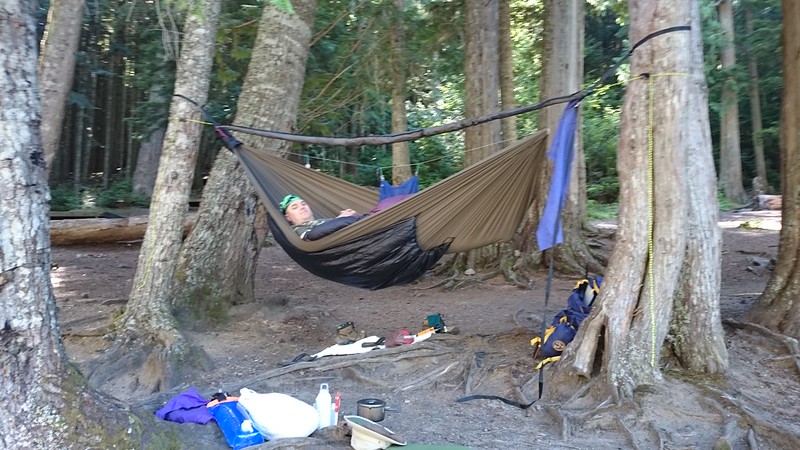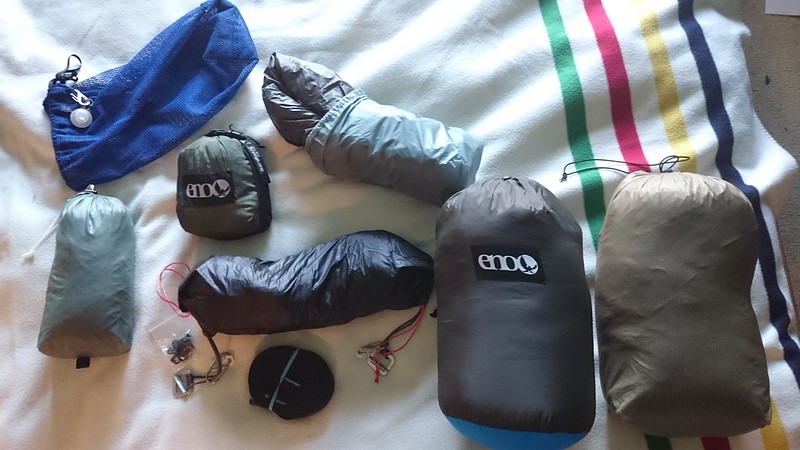I haven written in a while. No excuse, I just haven't felt like it and since this blog is for me rather than just about me I have no regrets about my absence. Now to get on with things....
Over the past six months, I have converted from a ground dwelling tent user to a tree hanging hammock camper. It was a slow progression. I have been a regular backpacker, a ultralight backpacker, a bushcrafter, and now a hammock guy. I have borrowed knowledge and skills from each of these activities. As my loads got smaller, lighter, and I got a little less dependent on my gear, I found my choice of shelters were changing. In short, camping under a tarp worked almost as well as a tent for most of the times I camped. Hammock campers use lightweight tarps as well.
About eight years ago, I was tasked with gear testing a bunch of hammocks from various companies and I hated it. After several very uncomfortable nights in one, I swore I'd never use one for camping again. I was new to the idea and I had no knowledge on how to do it right. It was uncomfortable and cold and I unavoidably woke up finding my sleeping bag and pads above me and unceremoniously showered on me every time I got out of the hammock for the call of nature. Then last Spring I observed some hikers in a neighboring campsite lounging in a hammock and basically using it more as a camp chair. It sounded like a good idea so I bought a cheap hammock and gave it a try. It was so comfortable that I thought I would give hammocks another chance as my overnight sheltering system. With the right gear and learned skills, I haven't looked back.
Here is an incredible resource for anyone just starting out

What I like about hammocks.
1. I'm getting older and using a hammock is more comfortable than sleeping on the ground.
2. Hammock systems are very modular so you only need to take what you need. (ie. If there are no bugs, leave the bugnet at home).
3. Hammock systems can be customized with components from different makers or from DIY projects.
5. Hammock shelters can be just as light or lighter than tents.
6. I don't need level ground or a debris free ground to camp.
What I don't like about hammocks.
1. Hammocks are basically solo shelters.
2. Hammocks need at least two trees(or other comparable anchor points) spaced 12 to
20 feet apart.
3. Unless you are a DIY guru, good quality hammock parts are hard to find locally.
The Gear
Everyone who knows me, knows how much I love gear and the more modular and customizable, the more attractive it is to me. I'm going to display my hammock system but it is personalized for me and what will work for you might be totally different and equally acceptable if it works for you.
It consists of components mostly made from the cottage industry because very few mainstream outdoor companies have shown interest in hammocks although camping hammock popularity is on the rise. My list is an example of interchangeable modules.
Hammock
- Dutchware Gear Netless 11' Hexon 2.4
Suspension
- Dutchware Gear Cinchbuckle & strap with Dutchclip
Tarp -
OES MacCat Deluxe SilPro
Snakeskins
- Hennessy Hammock
Hammock
Sock - Simply Light Designs Windbreaker 360
Bugnet -
ENO Guardian
Underquilt
- Jarbridge River 3/4 with Climashield APEX by
Arrowhead Equipment
Topquilt
- ENO Ignitor with 750 FP down.
I intend to use my hammock for Autumn and Winter coast camping this year. If anyone else is getting older and feeling the aches and pains that come with sleeping in the ground, I recommend trying a hammock (Thousands of Mayan Indians can't be wrong!). I wish I knew more and kept using one eight years ago.

